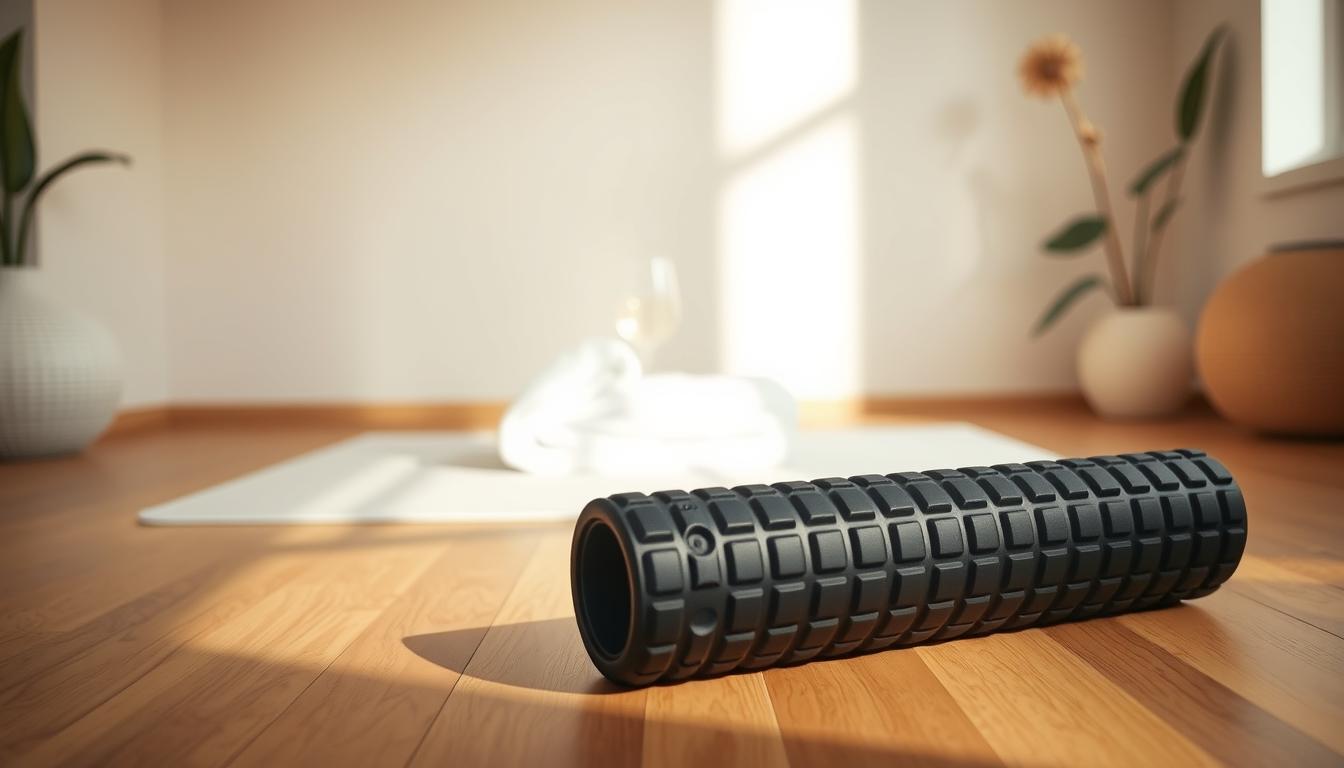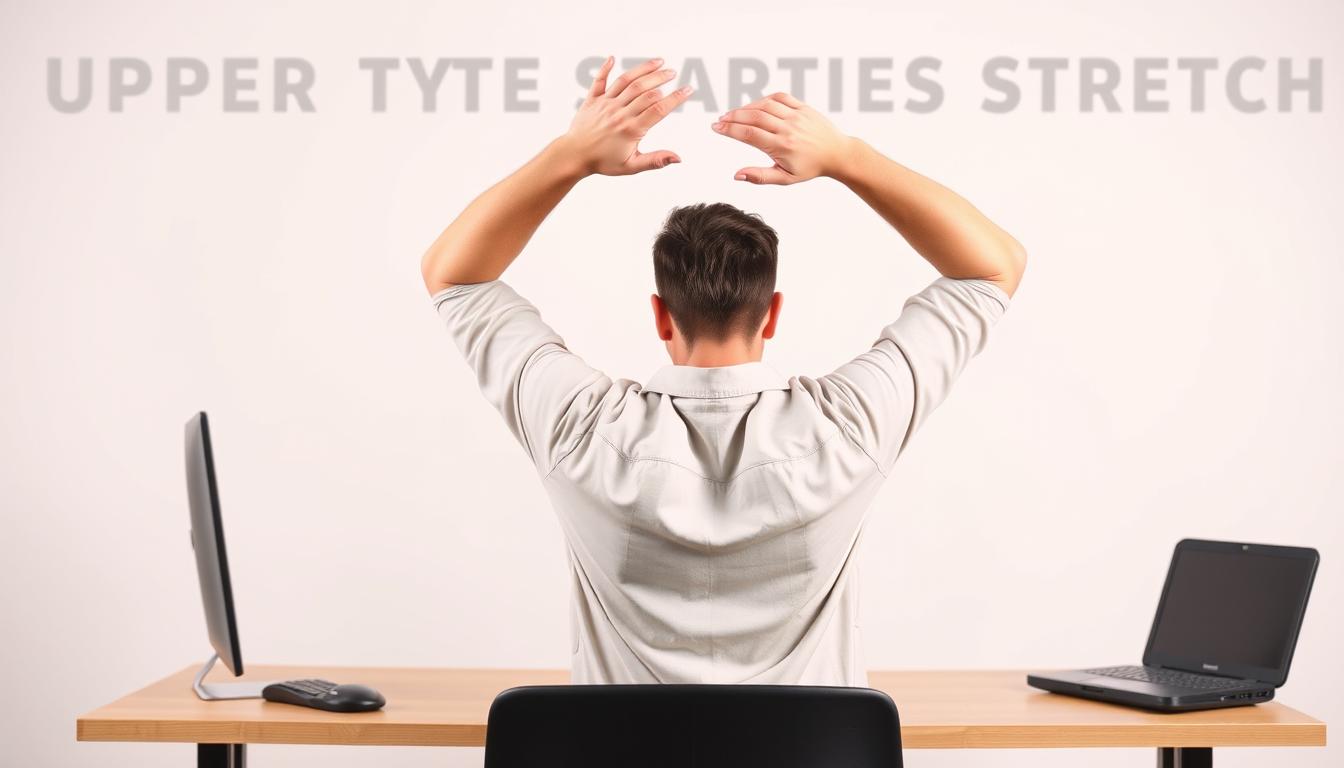More people are choosing careers in programming, leading to the rise of tech neck. This makes neck pain relief very important for programmers who sit in front of screens for hours. We will look at neck exercises and techniques to ease the pain from not sitting right.
By tackling tech neck issues, you can work better and feel more comfortable. Let’s check out the top seven moves to ease neck pain and boost your well-being.
Understanding Tech Neck and Its Symptoms
Tech neck, also known as “text neck,” comes from stressing our neck and upper back muscles. This happens when we stare at screens for too long. Not sitting or standing right while using technology can make it worse. Spotting the signs early is key to avoiding worse neck pain later.
What Is Tech Neck?
Tech neck happens when we often look down at our phones, tablets, or computers. This bad angle puts extra pressure on the neck, leading to pain and problems over time.
Common Symptoms of Tech Neck
People with tech neck might feel these things:
- Stiffness in the neck and shoulders
- Persistent headaches
- Muscle fatigue
- Reduced range of motion
- Pain that spreads to the arms
Knowing these tech neck symptoms can help fix problems before they get worse.
Long-Term Implications of Ignoring Neck Pain
Not taking care of tech neck can cause long-lasting neck pain. This might lead to bad posture and spine problems. Over time, this strain could cause slipped discs or arthritis in the neck area. This affects how we move and live every day.
Ergonomics: Setting Up Your Workspace
An ergonomic workspace boosts your comfort and work performance. Right chair support helps you sit correctly, avoiding neck and back pain. A good ergonomic chair supports your spine’s curve. This improves blood flow and eases neck muscle strain.
Importance of an Ergonomic Chair
Getting an ergonomic chair changes your workspace for the better. It keeps your body in the right position, especially during long work hours. It also keeps your spine aligned, cutting down discomfort in your neck and shoulders.
Adjusting Screen Height for Comfort
Setting your screen at the right height is key for comfort. Your monitor or laptop should be at your eye level. This prevents your neck from bending awkwardly. Use monitor stands or books to lift your screen. This setup helps fix your posture. Checking and adjusting your workspace setup regularly is good for your neck health.
Top 7 Neck Pain Relief Moves for Programmers
Programmers who are at their desks a lot can feel better by doing neck pain exercises. These exercises help ease neck pain and make your posture better.
Chin Tucks: Aligning Your Head with Your Spine
Chin tucks help your head line up with your spine. Gently pull your chin to your throat to work your neck muscles and keep your spine stable. This helps if you lean forward a lot at your computer.
Shoulder Blade Squeezes: Strengthening Upper Back Muscles
Shoulder blade squeezes make your upper back stronger. This supports good posture. Sit or stand up straight, squeeze your shoulder blades together, then release. This balances your upper body and helps your neck feel better.
Neck Rolls: Increasing Flexibility and Reducing Tension
Neck rolls make your neck more flexible and less tight. Move your head around gently in circles. Switch directions after a few times. This boosts blood flow and eases muscle tightness.
Pectoral Stretch: Opening Up the Chest
Pectoral stretches open your chest area. Stand in a doorway, put your forearms on the frame, and lean forward. This stretches your chest muscles, helps your shoulders relax, and reduces neck tension.
Thoracic Extension: Counteracting Slumped Posture
Thoracic extension exercises open your chest and stretch your back. Sit on the edge of a chair and lean back gently. This helps reduce neck pain and encourages a straighter spine.
Upper Trapezius Stretch: Relieving Tightness
An upper trapezius stretch eases neck tightness. Sit straight, tilt your head to one side, and gently pull the other side. This releases tension from poor posture.
Standing Desk Benefits: Incorporating Movement
A standing desk helps ease neck pain. Alternating between sitting and standing moves your body, reducing desk work strain. It encourages better posture and mini-exercises.
Importance of Taking Frequent Breaks
Taking breaks often during your workday is key to avoiding neck pain. Sitting too long can make your muscles tight and put more strain on your neck. By setting reminders to take breaks and move around, you’ll feel better and work better too.
Setting Reminders to Move
To fight the bad effects of sitting too much, set reminders to move. Use alarms on your devices to tell you to stand up, stretch, or walk a bit every 30 to 60 minutes. Moving this often is important to fix your posture and keep your blood flowing well.
Simple Stretch Routines to Do Every Hour
Adding easy stretches to your hourly routine can ease the pain from sitting too long. Try doing these:
- Neck stretches: Gently tilt your head side to side.
- Shoulder rolls: Rotate your shoulders forward and backward.
- Wrist stretches: Extend your arms and flex your wrists.
These quick stretches are good for stopping neck pain and make you feel more awake. And when you feel more awake, you get more done during the day.
Daily Neck Exercises to Strengthen and Stretch
Maintaining neck health calls for daily effort. Regular neck exercises help counter bad posture and sitting too much. They strengthen your neck muscles, prevent pain, and increase flexibility.
Incorporating Exercise into Your Routine
Making neck exercises a daily habit might seem hard, but it’s doable. Start by dedicating a few minutes every day, especially during breaks. This helps you keep a consistent routine, strengthening your neck and improving its health.
Sample Exercises to Combat Tech Neck
Here are a few exercises for your daily routine:
- Chin Tucks: Gently tuck your chin towards your chest while keeping your back straight. This movement targets neck muscles and promotes better alignment.
- Shoulder Blade Squeezes: Sit or stand tall, squeeze your shoulder blades together, and hold for a few seconds. This exercise strengthens the upper back and helps improve posture.
- Neck Rolls: Slowly roll your head in a circular motion to enhance flexibility and relieve tension in the neck area.
- Pectoral Stretch: Stand in a doorway, place your arms on the frame, and lean forward gently. This stretch opens up the chest, which can alleviate strain on the neck.
- Upper Trapezius Stretch: Tilt your head to one side and hold. This movement helps relieve tightness in the neck and shoulders.
Adding these stretches to your day helps prevent tech neck. Aim for short, regular sessions to keep your neck flexible and strong.
Heat and Cold Therapy for Relief
Neck pain from long hours at the computer can be managed with heat and cold therapy. These methods help relax muscles and reduce inflammation, making it easier to move freely and without pain.
Using Heat Therapy to Relax Muscles
Heat therapy helps muscles relax. By applying heating pads or warm compresses to your neck, blood flow improves, loosening tight spots. This warmth is comforting and eases the stiffness often felt from too much screen time.
Cold Therapy for Inflammation Relief
Cold therapy is great for fighting inflammation from muscle strains. Ice packs or frozen gel packs lessen swelling and cool down sore areas. Starting cold therapy quickly after feeling pain can help lessen it and speed up healing.
Alternating Between Heat and Cold for Optimal Results
Switching between heat and cold therapy gives the best relief. This approach relaxes muscles and reduces swelling at the same time. Start with heat to soothe and loosen muscles, then use cold to lessen swelling. This method is great after spending lots of time at a desk, keeping your neck free from tension and flexible.

Seeking Professional Help When Needed
Dealing with neck pain from tech neck is tough. If your neck still hurts after trying to fix it yourself, it’s time to see a pro. Going to a physical therapist can help a lot. They make special exercises just for you, to lessen your pain and fix your posture.
When to Consult a Physical Therapist
Knowing when to get help from a physical therapist is key. You should think about it if:
- Pain sticks around even after you’ve tried home remedies
- Moving starts to feel hard or painful
- Stiffness in your neck messes with your day-to-day life
The Role of Chiropractic Care in Neck Pain Management
Chiropractic care is super important for dealing with neck pain. Chiropractors know how to make your spine line up right, which helps get rid of pain and helps you heal. They use their hands to fix any spine issues that might be causing you pain. Adding chiropractic visits to your care can make your neck feel way better.
Conclusion
Programmers often get neck pain from long computer use. Knowing the causes and signs of neck pain helps. It’s important to use good desk setups and exercise to prevent tech neck. This keeps programmers healthy and good at their work.
Doing exercises, taking breaks, and getting help when needed are key. These steps lead to a work space without pain. It makes coding more fun and promotes a healthy way of living. By following these tips, programmers will work better and be more creative.



